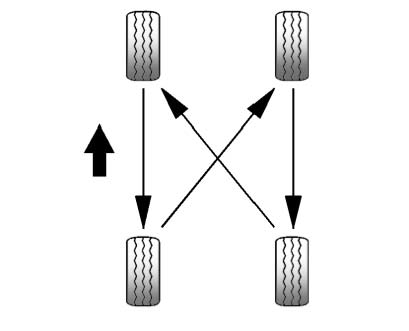Tire Rotation
Tires should be rotated every 12 000 km (7,500 mi). See Scheduled Maintenance .
Tires are rotated to achieve a uniform wear for all tires. The first rotation is the most important.
Any time unusual wear is noticed, rotate the tires as soon as possible and check the wheel alignment. Also check for damaged tires or wheels. Also check for damaged tires or wheels. See When It Is Time for New Tires and Wheel Replacement .

Use this rotation pattern when rotating the tires.
Do not include the compact spare tire in the tire rotation.
Adjust the front and rear tires to the recommended inflation pressure on the Tire and Loading Information label after the tires have been rotated See Tire Pressure and Vehicle Load Limits .
Reset the Tire Pressure Monitor System. SeeTire Pressure Monitor Operation .
Make certain that all wheel nuts are properly tightened. See “Wheel Nut Torque” under Capacities and Specifications .
![]() WARNING
WARNING
Rust or dirt on a wheel, or on the parts to which it is fastened, can make wheel nuts become loose after time. The wheel could come off and cause an accident. When changing a wheel, remove any rust or dirt from places where the wheel attaches to the vehicle. In an emergency, a cloth or a paper towel can be used; however, use a scraper or wire brush later to remove all rust or dirt.
Lightly coat the center of the wheel hub with wheel bearing grease after a wheel change or tire rotation to prevent corrosion or rust build-up. Do not get grease on the flat wheel mounting surface or on the wheel nuts or bolts.
See also:
Windshield and Wiper Blades
Clean the outside of the windshield with glass cleaner.
Clean rubber blades using lint-free cloth or paper towel soaked with windshield
washer fluid or a mild detergent. Wash the windshield thoroug ...
Content Theft-Deterrent
Your vehicle may have the optional content
theft-deterrent alarm system.
To activate the theft-deterrent system:
1. Open the door.
2. Lock the door with the power door lock switch
or the Remote ...
Audio System
When using the in-vehicle Bluetooth system, sound
comes through the vehicle’s front audio system speakers
and overrides the audio system. Use the audio system
volume knob, during a call, to ch ...


